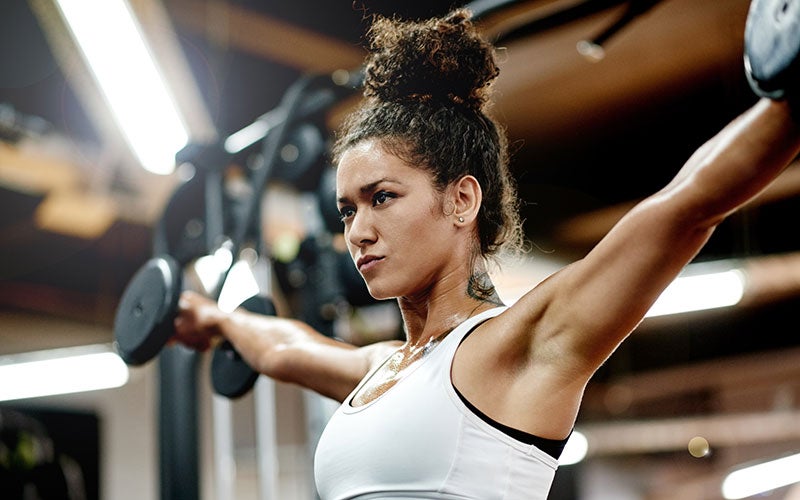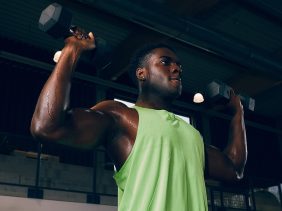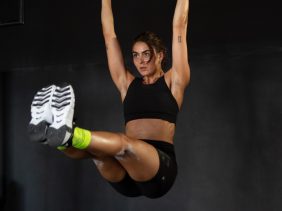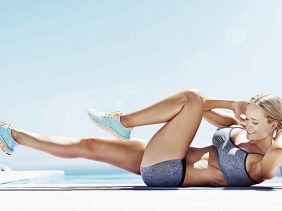7 Full-Body Dumbbell Exercises
 ©Mikolette
©Mikolette
In the last couple years, there was a run on dumbbells. Why, with gyms closed, is that what people were coveting? A few reasons. Dumbbells are highly versatile, can be used to train upper body, lower body, core, and can be part of HIIT training. Plus, they’re great for discovering strength imbalances — more on that later. Even if you’re back in the gym, you can skip a lot of the single-use weight machines and instead make a bee-line for the weights rack.
Related: What is more effective: Cardio or strength training for weight loss?
What makes dumbbells unique?
Weight is weight…or is it?
There are a few advantages that are unique to hand weights, including dumbbells and kettlebells, versus weight machines and even barbells. For starters, dumbbells require more dynamic control. Not to sound too obvious, but a weight is constantly pulled down by gravity. As you perform a movement — let’s say a bicep curl — you are controlling the weight as it moves through the air and while the dumbbell is pulling down, which forces large and small muscles in your shoulder and arm (and even chest and torso) to constantly make adjustments. If you’re using a bicep curl machine, the contraption is controlling the path of the movement. It’s great for isolating the bicep muscles, but it’ll undercut the involvement of other muscles. It’s not a bad thing — just different.
These supplements will help keep your body on tip-top form.
And dumbbells can uncover imbalances and help correct them. Let’s take that bicep curl example again. When you’re performing the movement on the machine with both arms at once, a dominant arm that’s stronger might mask a weakness in the non-dominant arm. On the other hand, bicep curls with a dumbbell won’t allow overcompensation. You don’t have to overtrain your non-dominant side. But decoupling your stronger half from your weaker one helps balance things out.
The same principle applies to barbell work. Deadlifting with a barbell is excellent, but one side could edge out another — plus the hardware itself is extremely stable. Now, split the weight into two dumbbells, both of which need to be controlled individually, and you’re talking about a different challenge. You’re not going to be lifting as much with dumbbells versus a barbell, so think about these movements as complementing each other.
Tips for dumbbell workouts
Technique always comes first! That’s how you avoid injury. As a beginner, take your time to learn the correct form before you reach for dumbbells. Once you’ve got the technique down, fetch some light weights and go up from there. Even seasoned exercisers can use a little help with form from time to time. If you have an experienced gym buddy, or want to spring for a trainer, you can make sure your form is locked in. Not only is it the way to stave off injury, but proper form focuses on the muscles a particular exercise is supposed to work, helping you get stronger in the long run.
Vary up your workouts. Your muscles adapt to any load over time. So it’s important to set new training stimuli to make progress in training, which promotes muscle building and strength. Increasing the weight is one option. Or you can increase the Time Under Tension (TUT), meaning the actual amount of time your muscle is working with each rep. For instance, you could do a dumbbell overhead press by pressing up quickly, then lowering very slowly.
Remember; light = fast, heavy = slow. If you’re doing a HIIT workout with moves that use dumbbells, the goal is getting your heart-rate up and working on your endurance. Conversely, strength sessions are when you’re focusing on muscle-building. Be wary of mixing the two, and only do so if you really know what you’re doing. Too fast during HIIT again risks an injury, especially toward the end of the workout when your body and mind are redlining, and going too light during a strength session won’t necessarily get you where you want to go.
To improve your body you need to know your body. Find out more here.
The workout
Warm up for 10 minutes (think jumping jacks, bodyweight squats, good mornings), then get to the workout. Do 8 to 12 reps of each move, going steadily from one move to the next, then rest a minute or two. Repeat two or three times.
- Bulgarian split squat
Stand facing away from a bench or plyo box, a light- to medium dumbbell in each hand, and take a big step forward. Then, reach your left foot back and place the top of your foot on the bench, toes pointed behind you, to start. Engage shoulder blades and core, and drop down into a squat so the right knee tracks over toes and torso stays tall. Press through your right foot to reverse to start. Do all reps on the right leg, then switch sides.
- Romanian deadlift
Stand, feet shoulder-width apart, legs soft but mostly straight, holding a medium to heavy dumbbell in each hand, weights close to the front of your thighs, palms facing in, to start. Engage shoulder blades and core, and keep knees soft but straight, press butt back and lower dumbbells a few inches under knees. Then, press hips forward to raise the weights. The end of the lift is when hips are fully locked out. That’s one rep. If that’s too easy, this can be done while balancing on one leg, keeping hips straight to avoid tipping your pelvis to the side.
- Bent-over rows
Stand with a bench or box on your left, a light, medium, or heavy dumbbell in your right hand. Bend forward so the torso is at a 45° angle, left hand on the bench, legs slightly bent, butt back, to start. Engage shoulder blades and core, then, with a neutral wrist, drop weight toward floor, and pull up so weight comes toward stomach. Reverse for one rep. Do all reps with right arm, then switch sides.
Try our whey protein either before or after exercising.
- Bench press
Sit on the edge of a bench, feet on the floor, holding a medium to heavy dumbbell in each hand, the bottom of the weight resting on thighs. While the weights stay connected to your thighs, gently rock your body backward to lay on bench, arms locked out, weights over shoulders, and place feet on floor, to start. Lower elbows until weights are just above chest, then reverse to start for one rep. After all reps are complete, lift legs to weights and rock forward to return to sitting.
- Lateral raises
Stand with feet hip-width apart, torso bent slightly forward, elbows slightly bent, hands holding a light dumbbell, to start. Maintain body position and lift arms to the sides and just in front of the body until weights are at shoulder-height, then reverse to start.
- Bicep curls
Stand, holding a light, medium, or heavy dumbbell in each hand, palms facing out, to start. Engage shoulders and core, and, keeping elbows close to body, bend arms and bring weights toward armpits, then reverse to start, for one rep.
- Single-arm overhead tricep extension
Sit on the edge of a bench, a medium to heavy dumbbell in right hand. Press right arm overhead so weight tracks over top of right shoulder until arm is locked out, left arm stabilising right working arm, to start. Lower dumbbell behind your head, then reverse for one rep. Do all reps with right arm, then switch sides.
More healthy living tips from foodspring:
- More performance in the gym through mobility training
- The #1 Reason Your Muscles Aren’t Growing
- 6 Surprising Effects Lifting Weights, According to Science
- Push & Pull – The Only 6 Moves Your Need to Know to Build Strength
Sources for this article
We at foodspring use only high-quality sources, including peer-reviewed studies, to support the facts within our articles. Read our editorial policy to learn more about how we fact-check and keep our content accurate, reliable, and trustworthy.





























